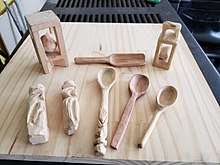Whittling
Whittling may refer either to the art of carving shapes out of raw wood using a knife or a time-occupying, non-artistic (contrast wood carving for artistic process) process of repeatedly shaving slivers from a piece of wood.[1]:14[2]:10[3]:30 It is used by many as a pastime, or as a way to make artistic creations.

Background of whittling
Casual whittling is typically performed with a light, small-bladed knife, usually a pocket knife. Specialized whittling knives, with fixed single blades, are preferred for sculpting artistic work. They have thick handles which are easier to grip for long periods and have better leverage, allowing more precise control and pressure.
Occasionally the terms "whittling" and "carving" are used interchangeably, but they are different arts. Carving employs the use of chisels, gouges, with or without a mallet, while whittling involves only the use of a knife.[2]:10 Carving frequently involves powered equipment such as lathes.
In industrialized areas of the world, whittling is mainly a hobby and not an occupational activity as it was before powered wood working equipment enabled modern production.
"Splash whittling" is a historical, decorative technique in Norway using an ax to create a herringbone pattern.[4]
Safety
It's a good idea to protect your thumb with a leather thimble, and your holding hand with a cut-resistant glove.
Wood types
While any type of wood can be used for whittling, there are woods which are easier to work with and whittle better than others. Soft woods with a small grain, such as basswood, are easier to whittle and are relatively inexpensive. Hardwoods are more difficult to whittle.
See also
References
- Wilson, Harold B. (1996). Democracy and the Work Place. Black Rose Books. ISBN 978-0919618220.
- Tangerman, E. J. (1962). Whittling and Woodcarving. Dover. ISBN 978-0486209654.
- Hunt, Lester I. (1979). "Pocketknife Art". Design For Arts in Education. 81 (1): 30–33. doi:10.1080/07320973.1979.9939989.
- THUN, TERJE; STORSLETTEN, OLA (2011). "Out of fashion and out of mind; some puzzles in building history solved by means of dendrochronology" (PDF). Stavanger. Retrieved 4 January 2014.